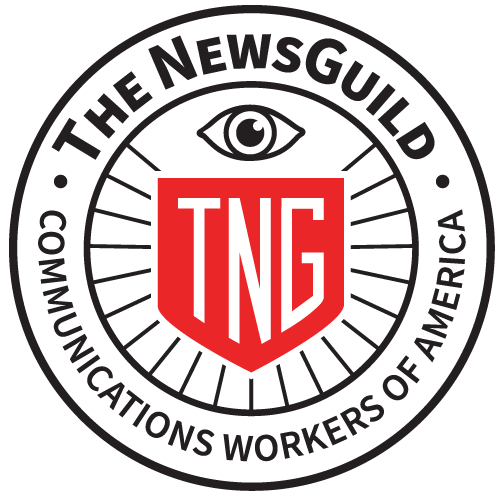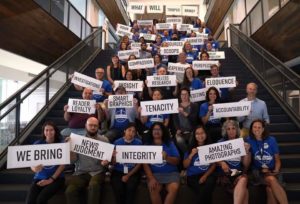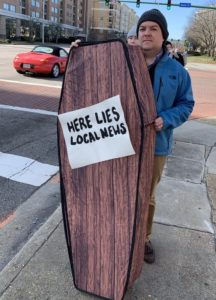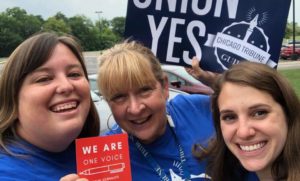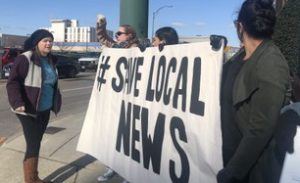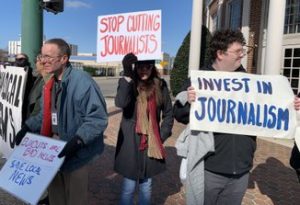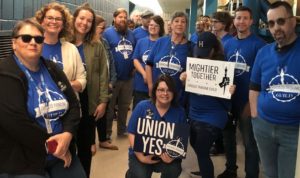Executive Summary
Tribune Publishing employees are concerned about the direction taken by their company and the future of their individual newspapers. To counter profit-driven cuts to newsrooms, journalists at several Tribune properties have joined a wave of union organizing in the media sector. In the past three years, employees at ten Tribune papers have affiliated with The NewsGuild-CWA to gain a voice in their workplaces. [Download the report]
Most recently, employees across the company were concerned when hedge fund Alden Global Capital took a 32% stake in Tribune Publishing in November 2019. They had watched as Alden hollowed out newspapers of the Digital First Media chain for years. Alden has a reputation within the news industry for wanton cost-cutting, job destruction, and the extraction of cash from individual papers.
In December 2019, the Chicago NewsGuild submitted a shareholder proposal for the company’s annual meeting that asked the company to report on the state of journalism among its papers. The company contested the proposal with the Securities and Exchange Commission and managed to get it omitted from the proxy statement sent to shareholders in advance of the annual meeting on a technicality. Believing that such a report was long overdue, NewsGuild-CWA members decided to use their eyes and ears to publish their own report, drawing on a survey of Tribune employees and other primary source material.
Tribune Publishing employees fear for the state of journalism and worry about the impact on their communities and themselves:
- 95% of the respondents report that some news beats are no longer covered at their papers and they detail those lost beats;
- 83% of the respondents have seen negative concrete changes at their papers since the Alden investment;
- 76% of the respondents believe the overall quality of coverage has decreased as a result of cuts to staffing and coverage;
- 75% of the respondents worry about caring for their families or meeting their financial responsibilities because of the threat of job reductions.
Journalists have witnessed the changes taking place in the news industry, particularly the transition from print to digital. The respondents applauded many of the steps the company has undertaken to become more digitally oriented. However, 62% believed the company is not serious in attracting new readers and new advertising with inadequate investment in digital infrastructure and strategy.
In a recent Slack conversation with CEO Terry Jimenez, Tribune Publishing employees articulated their deep concern that Tribune has prioritized paying shareholder dividends while furloughing employees. During this coronavirus pandemic, it appears that the burdens of lost advertising revenue are falling disproportionately on frontline workers.
The quantitative and qualitative findings in this report should be considered carefully by all Tribune Publishing stakeholders. To ensure the future of Tribune’s storied mastheads, investors and subscribers should call on Tribune leadership to give a greater voice to the workers, who know their communities and readers well. With investment in quality journalism, the mastheads of Tribune Publishing can continue their critical mission.
Introduction
Tribune publications have weathered a number of storms in the last several years. Sam Zell’s leveraged buyout of Tribune Inc. in December 2007 – at the cusp of the financial crisis – turned into the “deal from hell” (Zell’s term). In December 2008, Zell filed for reorganization, and the company spent four years in bankruptcy. In 2014, Tribune, Inc. split into two companies – Tribune Media and Tribune Publishing – with the latter saddled with $350 million in debt used to pay a $275 million special dividend to shareholders. In February 2016, the Chicago tech entrepreneur Michael Ferro, Jr. became the largest shareholder and board chair in Tribune Publishing. Later that year, the company adopted the name “tronc,” short for Tribune Online Content. Mr. Ferro left his board position in March 2018 amid accusations of sexual harassment. He sold his 25% stake in the company to New York hedge fund Alden Global Capital in November 2019. Alden quickly increased its stake to 32%. To say that Tribune stakeholders – readers, communities, employees, and shareholders – have been through a whirlwind would be an understatement.
The Chicago NewsGuild (TNG-CWA Local 34017) filed a shareholder proposal in December 2019 that requested Tribune Publishing produce, and make available to shareholders and other stakeholders, an annual report on journalism, similar to the way many public companies have produced sustainability reports on environmental, social, and governance issues. The company contested the proposal and prevailed on the Securities and Exchange Commission to use a technicality to exclude the proposal from the proxy statement and deprive shareholders of the opportunity to vote on it. In contrast, Gannett did not contest a similar proposal, it appears in the 2020 proxy statement, and the company has chosen not to recommend either for or against.
Given the recent changes to the news industry and to Tribune Publishing, The NewsGuild-CWA thought it important for all stakeholders to understand the impact the company’s business decisions have on its core product: journalism. Tracking and reporting on Tribune Publishing’s news output is critical for all stakeholders to assess the company. We hoped that Tribune would produce a report with baseline data on staffing, insourcing/outsourcing, beats covered at each property, geographic coverage areas, among other metrics. Since employees do not have access to much of that operational data, we relied on the eyes and ears of news workers.
The NewsGuild-CWA conducted a survey of Tribune employees between April 13 and April 24, 2020. The survey contained 29 questions, both quantitative and qualitative. Tribune employees also shared their views in a Slack conversation with CEO Terry Jimenez, CEO of Tribune Publishing. Together this source data enables us to report on the pride employees hold in their papers’ reporting and their concerns about company priorities, the anxiety about the direction of coverage at their papers, the news beats no longer covered, and the changes since the Alden investment. Altogether, the report represents a means to understand how our company creates value.
The Survey Respondents
Employees from 14 different Tribune bargaining units have organized with The NewsGuild-CWA – Chicago Tribune, the Chicago suburban papers, the Design Production Studio (DPS), the Hartford Courant, The Morning Call in Allentown, PA, The Baltimore Sun, the Capital Gazette and Maryland regional papers, the Orlando Sentinel, and The Virginian-Pilot, the Daily Press, and smaller papers in southern Virginia.
Among the su]rvey respondents, the average length of employment was 10 years, 2 months. The average time in the journalism industry was 16 years, 6 months. The gender mix was split – 46% female, 44% male, and 10% declined to answer. The racial/ethnic mix was 73% white, 19% nonwhite, and 10% declined to answer.
In terms of their compensation, the largest group of respondents has an annual salary between $40,000 and $55,000.
Most respondents (72%) stated they had not had a salary change within the last two years.
When asked if they worried about caring for their family or meeting their own financial responsibilities because they fear job reductions at their newspaper, 98% answered in the affirmative.
Pride in Colleagues
When asked about Tribune journalism, survey respondents praised their colleagues.
Journalists at Tribune papers have frequently been cited by prize committees for the high quality of their work. Between 2016 and 2020, papers that are now under Tribune Publishing won at least 10 major prizes and were finalists for another 10 awards. See Table 1 in the Appendix.
Tribune employees have an overwhelming amount of pride for the work produced at their newspapers. Respondents were asked to list the three Tribune Publishing stories that made them the proudest. For example:
- Journalists responding at The Morning Call in the Lehigh Valley were proud of stories covering unsolved murder cases; the changes in Pennsylvania’s coal industry; the cash bail system in the state; a suicidal car explosion; a disabled cyclist; and the career end for a marathoner.
- Respondents at The Baltimore Sun and the Maryland suburban papers mentioned the Capital Gazette shootings; the problem of gun violence; a hate crime shooting; the corruption of the Baltimore mayor; high school athletes trying to train during the pandemic; several articles on the effects of COVID-19; a house razed on short notice; profiles of both the Baltimore Ravens star quarterback and former Baltimore Oriole Hall-of-Fame third baseman; the Baltimore contribution to hip hop music; and home repair scams.
- Survey participants at the Chicago Tribune and the Chicago suburban papers mentioned the killing of Laquan McDonald by a Chicago police officer, the investigation, and the trial; a profile of a defendant charged with murdering an off-duty police officer; the effect of sickle cell anemia on African American men; the abuse of “quiet rooms” for school children; sexual misconduct in Chicago public schools; a retrospective look at the 1919 race riots; an investigation into John Wayne Gacy, the serial killer who was executed in 1994; the story of the boxer Jack Johnson’s desegregated night club; an investigation into how hospital emergency rooms handle rape victims and rape kits; and the lack of affordable housing in the suburbs.
- Respondents at the Hartford Courant mentioned the story of a UConn basketball player and her eating disorder; an obituary for a Courant sports writer; the coverage of the Sandy Hook murders; exposing corruption in the administration of the Connecticut governor; the story of two homeless men living by the Connecticut River; stories highlighting the 75-year anniversary of the Hartford circus fire; gun violence in Hartford; and the 1999 Lottery Corporation shooting that won a Pulitzer.
- Respondents at the Orlando Sentinel mentioned the suicide of a man whose case was mishandled by a local jail; an exploration of the failures of Florida’s unemployment system in the midst of the coronavirus shutdown; a look at how the pandemic has affected the Hispanic community; an investigation into the lives of theme park workers; school vouchers going to schools that discriminate against LGBTQ students; and the underground Orlando jazz community.
- Respondents at the Virginia papers mentioned the public expenditures for unused jail beds; mental illness in prisons; vermin in public schools; the story of police abusing a developmentally delayed adolescent, his conviction, and community attempts to exonerate 15 years later; the shootings at the Virginia Beach municipal center; the coverage of Governor Ralph Northam’s history wearing blackface; and an investigation into Blackwater – “America’s private army.”
The Challenges Facing News Organizations
News organizations have two main revenue sources – advertising and circulation. Distribution of news through the Internet and the rise of digital media have challenged the traditional business models of newspapers. Driving revenues through digital advertising is challenging given the extent to which Facebook, Google, and Amazon reportedly dominate and control more than 60% of the market.
We also live in a time when the U.S. president has declared the media to be the “enemy of the people.” The lack of online regulation has permitted purveyors of “fake news” to assault the values of journalism. At the same time, local news remains among the media organizations that Americans trust the most. It is not an exaggeration to say we are at a historic moment for the Fourth Estate, the watchdog for democracy.
The survey asked respondents to describe the efforts taken by their news publication “to attract more readers or more advertisers.” The respondents noted several themes, focusing on digital initiatives. Many employees responding to the survey expressed support for these initiatives and for the staff who carry them out, tempered by concern that a focus on digital traffic can undermine the imperatives of good news coverage.
Digital journalism in general: Some of the survey respondents described efforts by their newsrooms to move to digital publishing and to monetize that medium. Several Tribune employees responding to the survey noted a variety of digital circulation promotions. According to a respondent, the Orlando Sentinel has offered digital subscriptions at very low rates – starting at as little as a penny a day. A Chicago Tribune survey participant described the use of tweets to encourage followers to buy digital subscriptions. A respondent who writes for both The Virginian-Pilot and the Daily Press described a “good online push” that included discounts and extra pages in the e-edition.
Some of the Tribune employees answering the survey were concerned about the quality of journalism that resulted from the transition to digital. A Baltimore Sun respondent suggested that attempts to increase audience engagement sometimes hurt the quality of writing. Several journalists expressed concerns at headlines designed to increase clicks. An Orlando Sentinel reporter noted the stress of producing for digital. A Chicago Tribune reporter found that “stories without pictures are buried no matter the quality or time it took to produce the tales.”
Increasing digital circulation: A Chicago Tribune worker noted a big push to attract more digital subscribers. Another Chicago Tribune respondent found that “lots of people like our coronavirus coverage, and they should.” Several respondents were concerned about an overemphasis on coronavirus coverage to the exclusion of other important coverage. A few respondents suggested a danger in responding simply to what readers think they want instead of venturing into new arena to interest their audience. A Virginian-Pilot worker observed that the newsroom was tracking the kinds of stories people read in order to promote digital subscriptions.
Five respondents noted audience engagement at their papers. A Hartford Courant worker stated, “Social Media, Newsletters, Community engagement …. I know all the people involved and can assure you that they’re doing everything they can.” The Sun Sentinel created an entire audience engagement team, including a reporter for viral/trending news and another position that fields questions from readers and then attempts to answer them. A Chicago Tribune respondent noted that newsroom staff wrote thank-you notes for readers when they hit 100,000 readers. At the Orlando Sentinel, one journalist stated: “editors highlight reporters who attract more subscribers as if that’s something we can control!”
Print-digital balance: The transition to digital affects the nature of journalism. One Baltimore Sun journalist said that attempts to generate additional page views limited the ability to do the in-depth journalism their readers want. This journalist felt the paper was more concerned with internet advertising than seeking appropriate balance for readers. One journalist from the Naperville Sun (a Chicago suburban paper) stated: “People constantly ask me where they can get a copy of the newspaper.” A Chicago Tribune reporter noted that one can break a story online, watch competitors catch up, and then space is unavailable in the printed paper.
Metrics that help and hurt: A Chicago Tribune respondent appreciated the newsroom metrics provided by management to understand audience, although other respondents questioned the validity of strict adherence to such measures. An Orlando Sentinel respondent stated that journalists study analytics more than in the past: “I’m more aware of my analytics on story and how I’m doing individually – which is stressful at times.” A Baltimore Sun respondent spoke approvingly of the use of Search Engine Optimization – the process of increasing page views by increasing the visibility of a website or a web page to users of a web search engine – to increase readership. Respondents noted a constant monitoring of digital subscriptions.
Overall, the company has not been serious: When respondents were asked if their news publication / group had made serious changes to attract more advertising or to increase circulation, 62% said that the changes introduced have not been serious enough to address decline in both revenue sources.
Cuts to Staff and News Coverage
The NewsGuild-CWA survey asked respondents if they had seen job reductions at their worksite: 97% stated in the affirmative. The job cuts have come in a mix of buyouts and layoffs, reflecting a trend across the industry.
Fewer jobs mean more work for the remaining employees. The survey asked respondents if the job reductions had meant their work was more difficult: 79% reported that their jobs were now more difficult. A reporter from the Howard County Times (Maryland suburban paper) noted, “I knew stories were still slipping through the cracks and I was unable to cover them. It was extremely stressful.”
The survey then asked: “If you have had job reductions at your worksite, were the news beats previously covered by departed employee(s) reassigned to another person(s)?” Among the survey respondents, 81% stated that beats have been reassigned.
When asked if the quality of the reporting in those newly covered beats had improved, declined or stayed the same, 76% reported that the quality had declined.
Reporters covering multiple beats: Survey participants were asked the question: “In instances where a news beat is covered by an existing employee, is he/she still covering their old news beat?” According to 63% of the respondents, those existing Tribune workers are covering two or more news beats.
At The Morning Call, local news reporters now cover up to eight municipalities – mayor, city council, budgets, and police. According to one journalist, “they simply can’t keep up.”
At the Orlando Sentinel, according to one journalist, “we provide little coverage of Seminole County/Lake County/Osceola County schools. Our coverage of Osceola and Lake Counties, as well as smaller municipalities in Orange and Seminole counties, has become very sparse.” Another employee opined: “We’ve lost many senior veteran reporters who had institutional knowledge that’s badly missed.”
A Baltimore Sun respondent was concerned that the paper no longer had a dedicated health reporter and said that health issues are addressed by a reporter who covers real estate. A journalist from the Capital Gazette stated, “we’ve lost an entertainment reporter, a sports editor, a photographer, and a sports reporter. It all still gets covered, but not as well because people have to take on multiple jobs.”
At the Hartford Courant, the following beats are covered by reporters also covering other beats: state agencies, state police, prisons, state education, health, labor, casinos, transportation, housing, environment/science, consumer affairs, and aviation. The coverage of multiple Connecticut towns that previously had a dedicated reporter is now covered by a single reporter.
In Chicago, the shutdown of the Tribune-owned Spanish-language Hoy has meant a reduction in coverage, relevant to the Latino community.
When asked what beats were no longer covered, a Virginia Daily Press employee said: “Entertainment, entire localities, sports columns, college sports, photography, science/environment, shipbuilding and defense contracting, education, and history.”
Respondents at virtually every Tribune publication lamented the weakened coverage of high school sports.
The problem reported is staffing. At the Chicago Tribune, “the trouble is that many of the beats are understaffed. We used to have different people covering tollway, airports and transportation and now we have one person doing it all.” At the Hartford Courant, “some of the work has been picked up by others (town reporters are covering more towns, for example, and we’ve started taking more education stories from a local online news outlet) but a lot has simply disappeared.”
News beats no longer covered. An overwhelming majority of survey participants (95%) answered that some beats were no longer covered by their news organizations.
The Morning Call, according to a journalist, no longer covers the city of Easton, one of the biggest cities in its coverage area, nor any of the suburbs around Easton. The paper does not cover Quakertown (municipal, schools) or the Slate Belt (all towns and schools). An employee at The Morning Call wrote: “The majority of entertainment beats are not covered. This includes: local and professional theater, entertainment venue announcements, concert advances, concert reviews, dance performances (college, professional); family entertainment, classical music advance and concerts (also reviews).” The publication no longer has regular coverage of health issues and family news.
At the Chicago Tribune, according to a respondent, “Cook County government, workplace issues and higher education are just a few areas that no longer have dedicated full-time reporters assigned to them.” Other journalists said higher education, environment, religion, labor issues, automobiles, and urban affairs were beats that are no longer regularly covered. The Chicago Tribune no longer has a dedicated reporter covering communities of color and other under-represented communities.
According to a survey participant, the Orlando Sentinel has lost its TV and media critic and its only African-American columnist. The paper has no women who regularly write columns, according to another survey respondent.
According to a survey participant from the Carroll County Times, the paper no longer covers all the municipalities of Carroll County, a largely rural, but increasingly suburban, county northwest of Baltimore.
Several survey respondents commented that The Virginian-Pilot no longer has a dedicated reporter covering the military. Yet, the Norfolk, Virginia, area has the largest concentration of military personnel outside the Pentagon. As one reporter lamented:
We are home to the largest naval base in the world and we don’t have a military reporter (we had three until last fall). One of the region’s largest cities went uncovered for 6 months before finally being replaced (internally). We live in coastal cities and have no one covering the environment. We have no news librarians. Education beats went unfilled for almost a year (then were only filled internally, by adding responsibilities to other reporters). We’ve lost multiple business reporters. We’ve lost our science reporter. We lost our federal politics reporter and two state politics reporters.
At the Hartford Courant, according to one journalist, “we no longer have a Hartford police reporter, a Hartford education reporter, a general education reporter, an environmental reporter, an investigative reporter or a nature columnist.” The paper has also lost reporters who have not been replaced – medicine, consumer affairs – as well as a humor columnist, a music critic, and a book reviewer.
Digital Innovation and Strategy
While a majority of Tribune employees believe that efforts to boost circulation and advertising revenues have not succeeded, the respondents do find that management has made many efforts to transition to digital news. Respondents were given a more granular question: “The transition from print to digital is a defining feature of the news industry. Do you agree that your news publication / group has done a good job in making this transition?” A bare majority (52%) agreed that their unit had done a good job in transitioning to digital. (70% of the participants mostly mildly agreed or disagreed with the sentence.)
Applause from employees: The Chicago Tribune newsroom, according to one journalist, “clearly prioritizes digital journalism, and subscriptions have risen as a result.” At the Hartford Courant, a respondent wrote, “We have had success in engaging with our audience via live Q&A’s with reporters, dedicated groups and a robust Instagram strategy.” At The Morning Call, employees were pleased that page views are increasing, but whether this will translate to increased revenue is uncertain.
A respondent said that at the Orlando Sentinel, “We are writing breaking news online as fast as we can. We often update the story several times with deeper updates when we’re able.”
At The Virginian-Pilot, a survey participant stated, “We have focused on covering stories that our online audiences want using fairly detailed metrics, leading to a boost in digital subscriptions.”
Digital success is not enough: A Chicago Tribune respondent wrote, “We’ve talked a lot about focusing on digital subscriber growth and have achieved some success. However, those efforts don’t seem to have been accompanied by enough growth in online subscription and advertising revenue to offset losses in other areas.”
A Baltimore Sun respondent wanted the paper to do more: “I believe we are missing out by discontinuing podcasts. Podcasts are an opportunity to showcase our reporting in a different format to different (younger!) audiences, and they could be a source of revenue if pitched correctly to advertisers.”
A Chicago Tribune survey participant wrote: “The paper is going digital first, but its gleeful determination to kill the print product, which still sells in this town, is a mistake.”
A respondent from the Hartford Courant wrote: “The major failure is that this company has essentially given up on print. Print is still very popular in Europe, Asia and South America. They approach it from a different perspective than we do. I think we should have put more effort into researching why those regions still like print and what we need to do to follow their lead.”
Inadequate support for innovation: A Baltimore Sun politics reporter wrote, “We had a great podcast until management pulled the plug, and we previously had done video work until that also was de-emphasized by management.”
A respondent at the Hartford Courant stated, “We’ve had a lack of institutional support for trying new things. For example, podcasts and newsletters have little backing and are set up to fail before they get off the ground.”
At the Orlando Sentinel, a survey participant said, “We were told a couple of years ago that EVERY story had to have a video attached, and we weren’t given the resources to do it, which meant we were putting up some very low-quality videos.”
Flawed websites: Several survey participants complained about the quality of the website at their newspaper. One employee from The Morning Call wrote: “We are stuck using a website that was already pre-formatted and the design is horrible. This has been the case every time we’ve made the ‘transition’ to a new web design. Each one is clunkier than the next. The flaws in the site are many and no one will address them or fix them. Digital subscribers complain endlessly their logins don’t work, the website constantly refreshes in the middle of stories, ads sit on top of text, and more ads on top of those ads, etc. It’s not user-friendly and it’s not a good experience. They just won’t take the time to listen to reader feedback or fix anything wrong with the site.”
A chicagotribune.com respondent was more to the point: “Our website is terrible, pop-up ads everywhere, impossible to search. No one in upper management seems to care.”
A Virginian-Pilot journalist stated, “When Tribune bought us [ed. 2018] they changed our web page to one that elicits many complaints from readers – too may pop-up ads, hard to search.” Another Virginian-Pilot employee: “The Tribune template website is difficult to navigate. Tons of repetition. Tons of filler like ‘Best Reviews.’ If the effort is to disguise how thin our ranks are now, it’s not working.”
Managing people amidst inadequate staffing: A respondent from the Capital Gazette: “The company makes one person who was originally trained only in print do the job of 4-5 people in digital production. Social media is barely organized and only the biggest papers have strong social media. Instead of creating a policy of how to run different types of accounts, small papers are left floundering and make overworked editors – sometimes even photographers – try to learn how to manage a brand.”
A survey participant from the Chicago Tribune: “Lack of training in ARC [digital publishing platform]. We were not trained in all areas of the system only what management thought we needed to know.” This problem was echoed by another Chicago Tribune respondent who said there is a “lack of training across the newsroom as to why certain areas in story promotion matter.”
A Chicago Tribune survey participant found that “because we are so short on manpower, it’s only the rare story that warrants a splashy rollout or different layout that gets it.”
A Virginian-Pilot respondent said: “At one point, we had staffers who were able to create special projects for our digital presentation that made stories more engaging and helpful to readers. We have long lost those employees and Tribune didn’t see fit to replace them. The incredibly small digital team we have now is overworked and underappreciated. They’re tasked with the impossible.”
Staffing levels create other problems, as one Hartford Courant respondent stated, “We do not have the origination or copy editing that we need, so inaccuracies, typos, bad grammar are prevalent.”
Concern over Management Priorities during the Pandemic
In a powerful act of integrity and solidarity, a hundred unionized employees recently expressed their opposition to decisions by management to extract cash for shareholders while furloughing newsroom and commercial employees. The company relented and announced on May 8, 2020, the suspension of the dividend.
On April 30, 2020, a conversation took place on the message platform Slack between top management – including CEO Terry Jimenez – and employees about the sacrifices necessary to confront the economic problems triggered by the novel coronavirus. At one point, Jimenez deactivated his account to avoid being tagged.Because participants in the Slack conversation used their own names to speak with management, the employees are identified in this section.
Management was seeking furloughs for those employees earning between $40,000 and $67,000 a year and a 2-10% pay cut for those earning more than $67,000. For unionized employees, the pay changes needed to be negotiated with The NewsGuild-CWA bargaining units.
Dividend paid out, employee pay is cut: Front and center for Slack participants was the perception of unequal sacrifice among Tribune stakeholders. On March 4, 2020, the company released its 4Q2019 and full year earnings and announced that it had returned $62.9 million to shareholders in 2019. Two weeks earlier it declared a $0.25 dividend per share to stockholders as of March 2, 2020, payable March 16.
Tom Shortell, from The Morning Call, noted the irony of the dividend payout: “The $9 million of dividend checks went out to shareholders on March 16, the same day stay-at-home orders for The Morning Call’s coverage area were announced.”
The furloughs, according to the company, would save roughly $557,000 for the five units participating in the Slack conversation – Virginia, Maryland suburban papers, the Lehigh Valley, Hartford, and the Design Production Studio.[xvi] Jesse Leavenworth from the Hartford Courant noted that “Last quarter Tribune shelled out 16 times that amount to shareholders in dividends.”
Sarah Wojcik, from The Morning Call, wrote, “I have no illusions about the economic hardships the industry is facing right now. But the idea that Tribune could be putting myself and my colleagues on furloughs and permanently cutting the salaries of some while then turning around to pay out shareholder dividends feels like a betrayal. If individuals in our newsrooms are going to make a sacrifice for this company, the least Tribune can do is show the same dedication.”
Sara Gregory, from The Virginian-Pilot, said: “In the last few weeks, I’ve watched my colleagues work harder than ever before to serve our communities. All while feeling increasingly demoralized about the way the company treats us. We don’t have the PPE we need to report safely. We don’t have adequate leave if we get sick because of that. At the Pilot, we don’t even have an office anymore. We’re doing all of this with significantly fewer people because of repeated buyouts and jobs left unfilled due to attrition. And after all that, the company asks US to empty our pockets to help them save what’s essentially a rounding error?”
Ryan Murphy, from The Virginian-Pilot, wrote: “The company still hasn’t committed to halting dividends and investing in its newsrooms first. I’m profoundly disappointed.”
Binghui Huang, from The Morning Call, wrote: “I’m the health reporter at The Morning Call and it’s critical that I continue to report on my beat during this pandemic. Like other journalists in our newsrooms, taking a week of furlough a month is going to be a major hit to our readers who need information during this time. Please protect our newsrooms and suspend dividend payments.”
Taylor DeVille, from the Capital Gazette: “I am the only reporter in my newsroom reporting on four communities in Baltimore County. Getting this job has been my dream come true and my work is my favorite part of my life. I’ve been so proud to join this team with all of its talented, hardworking reporters and editors. But it’s become very clear that Tribune is not paying attention to, or does not care, how furloughs and permanent pay cuts for staff members who have given their all to our papers will actually affect them and their families—while saving Tribune a literal drop in the bucket, $557k. Without suspending dividend payments, this whole thing is incredibly inequitable.”
Kristin Karnopp, from the Design Production Studio, wrote, “I have worked for Tribune for almost 18 years, and I love my job. But I’ve only gotten one small raise over the last decade — a token to prevent unionizing — while I’ve watched the company hand out millions of dollars each year in shareholder dividends and executive bonuses…. Tribune, it’s time to do the right thing: Show your employees that you respect and value them in this unprecedented time, when many of us are scared and struggling.”
Alex Putterman, of the Hartford Courant, wrote: “Watching the Courant staff work so hard and produce so much incredible work during this crisis and always, I’m heart-broken that Tribune wants to reward us with pay cuts and furloughs.”
Short-changing employees: The COVID-19 pandemic is a crisis that no one anticipated. Nonetheless, Slack participants believed the company has not been creative in using various public policy options that could relieve the burden on employees while providing quality coverage to communities.
The unionized employees at Tribune have offered to negotiate a different approach to the company’s financial distress. The various bargaining units recommended the use of state work-share programs.
Currently, employees need to be off for several consecutive workdays to take advantage of unemployment compensation programs in their state. Under a work-share proposal, the employer would designate between 10% and 60%-70% of its workforce (depending on the state) to participate in the program. The employees would reduce hours by a percentage and would receive that percentage of the weekly unemployment compensation.
Because employees would be receiving unemployment compensation, they would be eligible to receive $600 a week from the Federal Pandemic Unemployment Compensation (FPUC), a feature of the CARES Act designed to stimulate the economy.
Tribune employees are speaking out in support of this common sense approach, available in 31 states in the U.S. Jesse Musto, from The Morning Call, said: “Implementing furloughs under work share wouldn’t just allow workers to provide for their families and weather the non-working periods, it would keep our newsrooms whole.”
Catalina Righter, from the Carroll County Times (Maryland suburban paper), wrote that “readers will notice the further drop in quality if staff are furloughed and not given the flexibility of a program like a work share. Their frustrations will last far beyond the length of the pandemic.”
According to NewsGuild-CWA staff representatives, the company rejected a work sharing proposal that would have provided financial relief to the company, more pay for its employees, and more news for communities.
Alarm over Ownership Changes
The NewsGuild-CWA units at Tribune Publishing have been alarmed by the announcement by Alden Global Capital that it had purchased 11,544,213 shares of the company over four weeks in October-November 2019. That stake represents 32% of the shares outstanding. On December 2, 2019, Tribune announced that two Alden representatives – Dana Goldsmith-Needleman and Christopher Minnetian – had been appointed to the board.
NewsGuild-CWA members are all too familiar with Alden, as they have watched the impact of its investment in MediaNews Group (MNG), also known as Digital First Media, the newspaper chain controlled by Alden. Under Alden control, DFM downsized its workforce at twice the industry average and sold off much of its real estate via an Alden-controlled real estate company. The company put at risk the retirement security of current and former employees by investing retirement assets in funds managed by Alden – to such an extent it was investigated by the U.S. Department of Labor. MNG has itself been transformed into a hedge fund, extracting cash from the company’s balance sheet to invest in projects well outside the news industry – Fred’s Inc., Monster Worldwide, Peabody Energy, and debt issued by Payless Holdings. Put another way, Alden has not only squeezed juice from the fruit but it has peeled away assets as well.
New York Times columnist Joe Nocera has described Alden’s approach to the news industry:
[I]t cuts and cuts, and then cuts some more, until there’s little left but a carcass. Speaking truth to power, the importance of the Fourth Estate to a functioning democracy, the idea of bearing witness — none of that matters to Freeman and his fellow hedgies at Alden Global. Their only goal is to suck out cash and redirect it elsewhere.
Jon Schleuss, president of The NewsGuild-CWA, wrote to the Tribune Publishing Board of Directors on December 20, 2019. He marshalled evidence collected by The NewsGuild over the previous five years on Alden and its behavior at 12 newspapers where NewsGuild representation has dropped from 1,552 to 397 employees over the course of eight years. He asked a series of questions about the board appointments of Ms. Needleman and Mr. Minnetian. He did not hear back from the board.
Meanwhile, Tribune Publishing offered buyouts to employees with at least 8 years seniority in January 2020. One executive allegedly claimed on a conference call that employees should be happy and should be “singing Glory Hallelujah” for such an offer. Sara Gregory, an education reporter at The Virginian-Pilot lamented: “I’ve seen people crying at the thought of leaving @virginianpilot and @Daily Press, but still haven’t seen anyone “singing glory hallelujah.” A Baltimore Sun employee felt an “existential dread” that the buyouts would be followed by layoffs.
Fears of downsizing were widely reported. For example, Baltimore Sun employees have been active in seeking out nonprofit investors in their “Save our Sun” campaign.
Two investigative journalists at the Chicago Tribune actively and publicly approached potential investors to buy their paper out from Alden, according to an article in The New York Times. The journalists had made a public plea in an op-ed in The Times the week before.
In early February 2020, then-CEO Timothy Knight announced that he was stepping down. Three days later new CEO Terry Jimenez fired Grant Whitmore, the chief digital operations officer. The top-level cuts also included the Senior Vice President, Sales and Strategy; the Vice President of marketing strategy; the Vice President of Creative and Strategy; and the Vice President of Business Optimization. In late February 2020, two top editors were forced out: Bruce Dold, publisher and editor-in-chief of the Chicago Tribune and Peter Kendall, managing editor.
For Tribune employees, the pandemic and the demand for furloughs are creating a wedge for Alden to expand its influence. According to the union leaders at the Chicago Tribune Guild, “We are fighting Alden now…. The economic downturn opened the door for them to try to gut us despite our union protections.”
In May 2020, The NewsGuild-CWA wrote to Tribune shareholders and asked that they withhold their votes for the two Alden directors.
The NewsGuild-CWA survey asked whether respondents had witnessed any concrete changes at their newspaper since Alden announced that it owned 32% of Tribune Publishing: 83% answered in the affirmative. Respondents were asked to describe those changes.
A journalist from The Morning Call wrote, “despite being told our digital subscriptions were up and despite $65M being given out in shareholder dividends, we once again had another round of buyouts. Reducing workforce is the hallmark of Alden. Our newsroom lost 17% of its staff and I am now the only reporter in my department left.”
A Baltimore Sun survey participant commented, “I’ve heard managers mutter under their breaths that Alden is the death blow, that’s we’re facing a merger, that this is the end of The Baltimore Sun. Our hiring processes were completely frozen, despite the fact that we’ve continued to lose employees through attrition. The Baltimore Sun, for example, doesn’t even have a sports editor despite the fact that our city is home to two major professional sports teams.”
A Chicago Tribune employee found “extreme demoralization on the part of reporters/editors, including those more senior in ‘good’ jobs who have upper leadership potential and prestigious roles at paper.” He also described “LOTS of departures in buyouts and/or people leaving for other jobs. People sometimes leave without other work lined up – a really bad sign.”
A Hartford Courant employee was succinct: “Newsroom morale is even lower, staff fear is worse.”
A Sun Sentinel respondent wrote that employees “were threatened with layoffs if enough people did not take buyouts. As a result, nine senior reporters, editors and photographers took buyouts; a huge loss to the newsroom and community.”
A Daily Press respondent found “managers’ paralysis because of uncertainty over what resources and direction in Chicago [headquarters] will take.”
Conclusion
Tribune Publishing employees are the eyes and ears of the company. They know what works and what doesn’t. They connect to readers and communities. They have spoken loud and clear: their publications are in trouble. They see the strides their papers have made in shifting to new platforms. They are also critical of attempts that could best be termed half-hearted. The responses to questions were thoughtful and caring: they want their newspapers to succeed. Unfortunately, they know their workplaces are understaffed and that the news beats of their communities are not sufficiently covered. They know that journalism has suffered as a result.
The 32% stake that Alden has taken in Tribune Publishing appears to employees as the denouement of a long process of misplaced priorities. They are disturbed and saddened that their company has become a cash machine for hedge fund executives and other Wall Street interests.
While the company’s stock has outperformed all other public news companies except The New York Times since the Alden investment, the sustainability of this business is increasingly uncertain.
Newspapers are a public good. They educate the public and are therefore critical to democratic governance. Whether it is local government or the competition of political ideas, newspapers allow citizens to make informed choices in electing leaders. They investigate corruption so citizens know insight into how their taxes are spent. Quality journalism is essential for American democracy. It can still also bring value to shareholders who invest for the long term.
The NewsGuild-CWA encourages Tribune Publishing to reverse course. It should reinvest in the journalism sought by communities and ensure adequate staffing of its newspapers. The company should end the focus on share price, stop paying out dividends, and strike a better balance among stakeholders, putting communities dependent on news first.
The NewsGuild-CWA stands ready to work with management to re-build quality journalism at Tribune Publishing.
APPENDIX
| Table 1: Recognition of Tribune Journalism from Various Prizes | |||||
| 2020 | Winner | Pulitzer | Local Reporting | Baltimore Sun | Financial relationship between mayor & hospital system |
| 2019 | Winner | Polk | Political Reporting | Baltimore Sun | Financial relationship between mayor & hospital system |
| 2019 | Winner | Pulitzer | Public Service | Sun Sentinel | Failings before / after deadly shooting at Marjorie Stoneman Douglas High School |
| 2019 | Finalist | IRE | Print/Online | Chicago Tribune | Through public records requests, examined schools’ use of “quiet rooms” for children |
| 2019 | Finalist | Pulitzer | Editorial Writing | Capital Gazette | Deeply personal writing about their newsroom massacre |
| 2019 | Finalist | IRE | Sports investigation | Baltimore Sun | Examination of financial records at Pimlico Racetrack to show lack of oversight |
| 2018 | Winner | SPJ | Deadline Reporting | Capital Gazette / Baltimore Sun |
Stories around the Capital Gazette newsroom massacre |
| 2018 | Winner | SPJ | Editorial Writing | Capital Gazette | Reflections on the newsroom massacre |
| 2018 | Finalist | Pulitzer | Investigative Reporting | Virginian-Pilot | Virginia’s parole board system |
| 2018 | Finalist | Pulitzer | Local Reporting | Chicago Tribune & ProPublica |
Inequality in local tax assessment through examination of 100 million records |
| 2017 | Winner | Pulitzer | Public Service | NY Daily News & ProPublica |
Police abuse of eviction rules |
| 2017 | Winner | Pulitzer | Feature Photography | Chicago Tribune | Portrayal of 10-year-old boy and mother coping after his shooting |
| 2017 | Winner | IRE | Investigations Triggered by Breaking News |
Chicago Tribune | Investigation into death of toddler and dysfunction of Illinois Dept. Children & Family Services |
| 2017 | Finalist | Pulitzer | Public Service | Chicago Tribune | Pharmaceutical practices in dispensing prescription drugs |
| 2017 | Finalist | Pulitzer | Breaking News | Orlando Sentinel | Coverage of the mass shooting at the Pulse nightclub |
| 2017 | Finalist | Pulitzer | Investigative Reporting | Chicago Tribune | Neglect and abuse at Illinois group homes for Illinois developmentally disabled |
| 2016 | Winner | IRE | Print/Online | Chicago Tribune | Neglect and abuse at Illinois group homes for Illinois developmentally disabled |
| 2016 | Winner | SPJ | Editorial Writing | Virginian-Pilot | Jailhouse death of 24-year-old man, arrested for stealing $5 in snacks |
| 2016 | Finalist | Pulitzer | Breaking News | Baltimore Sun | Coverage of the rioting after the death of Freddie Gray |
| 2016 | Finalist | Pulitzer | Editorial Writing | Baltimore Sun | Editorials demanding accountability after the death of Freddie Gray |
| IRE: Investigative Reporters & Editors Polk: George Polk award SPJ: Society of Professional Journalists |
|||||
Survey based on responses from 117 of 550 Tribune Publishing employees
